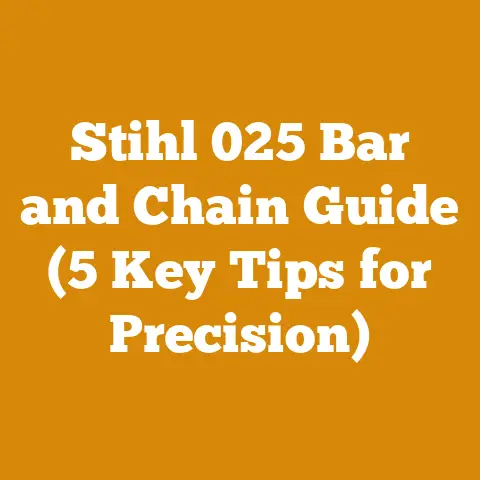3 Point Hitch Winch Guide (Essential Tips for Wood Processing Pros)
Let’s bust a myth right off the bat: You don’t need a massive, expensive skidder to move logs efficiently. A 3-point hitch winch on your tractor can be a game-changer, especially if you’re like me, working on smaller woodlots or managing firewood production on a manageable scale. I’ve spent years wrestling with logs, learning the hard way what works and what doesn’t. This guide distills that experience, providing you with the essential knowledge to choose, use, and maintain a 3-point hitch winch like a seasoned pro.
Understanding the Power of the 3-Point Hitch Winch
The 3-point hitch winch is an incredibly versatile tool for anyone involved in wood processing. It attaches to the 3-point hitch of your tractor, allowing you to pull logs from the woods to a landing area, even in difficult terrain. Think of it as your personal, portable logging solution.
What is a 3-Point Hitch Winch?
Simply put, it’s a winch mounted on a frame that connects to your tractor’s 3-point hitch. It uses a cable and hook to pull logs towards the tractor. The winch is typically powered by the tractor’s PTO (Power Take-Off) or, in some cases, hydraulically.
Why Choose a 3-Point Hitch Winch?
- Cost-Effective: Compared to specialized logging equipment, a 3-point hitch winch is a much more affordable option.
- Versatile: You can use your tractor for other tasks besides logging.
- Maneuverable: Tractors are generally more maneuverable than skidders, allowing you to access tighter spaces.
- Reduced Ground Disturbance: Compared to dragging logs, winching minimizes soil erosion and damage to the forest floor.
I remember one particular job where a customer insisted on using a skidder to clear a small patch of woods. The damage to their yard was considerable. I suggested a 3-point hitch winch for the next phase, and the difference was night and day.
Key Components of a 3-Point Hitch Winch
- Frame: The structural foundation of the winch, designed to attach to the tractor’s 3-point hitch.
- Winch Drum: The rotating cylinder that spools the cable.
- Cable: Typically steel or synthetic rope, used to pull the logs.
- Hook: Attaches to the log for pulling.
- PTO Shaft (if applicable): Connects the winch to the tractor’s PTO for power.
- Control Levers: Used to operate the winch (engage, disengage, brake).
- Fairlead: Guides the cable onto the drum, preventing wear and tear.
- Safety Features: Including brakes, overload protection, and emergency stop mechanisms.
Takeaway: A 3-point hitch winch offers a cost-effective and versatile solution for small-scale logging and firewood production. Understanding its components is the first step to safe and efficient operation.
Selecting the Right Winch for Your Needs
Choosing the right winch is crucial for safety and efficiency. Don’t just grab the cheapest one you find. Consider these factors carefully.
Tractor Horsepower and Winch Capacity
The first thing to consider is your tractor’s horsepower. The winch capacity should be matched to your tractor’s capabilities. A general rule of thumb is to choose a winch with a pulling capacity that is at least 1.5 times the weight of the heaviest logs you plan to move.
For example, if your tractor has 40 horsepower, you should look for a winch with a pulling capacity of at least 4,000 lbs. This provides a safety margin and prevents overloading the winch and your tractor.
I once saw a guy with a small garden tractor trying to use a winch designed for a much larger machine. The tractor was straining, the winch was overheating, and it was a recipe for disaster. Always match the tool to the job.
Types of Winches: PTO vs. Hydraulic
- PTO Winches: These are powered by the tractor’s PTO shaft. They are generally more powerful and faster than hydraulic winches. They are also typically more affordable.
- Hydraulic Winches: These are powered by the tractor’s hydraulic system. They offer smoother operation and more precise control. They are also less likely to overheat.
The best choice depends on your specific needs and the capabilities of your tractor. If you need raw power and speed, a PTO winch is the way to go. If you prioritize smooth operation and precise control, a hydraulic winch is a better choice.
Cable Length and Diameter
The cable length determines how far you can reach into the woods to retrieve logs. A longer cable is generally better, but it also adds weight and can be more difficult to manage. The cable diameter determines the strength of the cable. A thicker cable is stronger, but it is also heavier and more expensive.
I recommend choosing a cable length that is at least 100 feet. This will give you plenty of reach for most situations. As for the diameter, consult the winch manufacturer’s recommendations.
Key Features to Look For
- Automatic Brake: This is a crucial safety feature that prevents the log from rolling back down the hill if you release the control lever.
- Overload Protection: This feature protects the winch from damage if it is overloaded.
- Fairlead: A good fairlead will guide the cable onto the drum smoothly, preventing wear and tear.
- Remote Control (Optional): A remote control allows you to operate the winch from a distance, which can be very convenient.
I remember one incident where the automatic brake on my winch failed. Thankfully, I was able to react quickly and prevent a serious accident. Always check your safety features before each use.
Winch Brands and Models
There are many different winch brands and models available on the market. Some popular brands include Farmi, Norse, Uniforest, and Wallenstein. Do your research and read reviews before making a purchase. Consider the reputation of the brand, the availability of spare parts, and the warranty offered.
Takeaway: Careful selection of a 3-point hitch winch is critical. Match the winch to your tractor’s capabilities, consider the type of winch (PTO vs. Hydraulic), and look for key features like automatic brakes and overload protection.
Safe and Efficient Winch Operation: A Step-by-Step Guide
Operating a 3-point hitch winch safely and efficiently requires careful planning and execution. Don’t rush the process.
Pre-Operation Checklist
- Inspect the Winch: Check the cable for any signs of wear or damage. Make sure the hook is in good condition and the safety latch is working properly. Inspect the frame for any cracks or damage.
- Check the Tractor: Make sure the tractor is in good working order. Check the fluid levels, tire pressure, and brakes.
- Clear the Area: Remove any obstacles that could interfere with the winch operation.
- Wear Appropriate PPE: Wear safety glasses, gloves, and hearing protection.
- Inform Others: Let others in the area know that you will be operating the winch.
I always start my day with a thorough inspection of my equipment. It’s a small investment of time that can prevent serious accidents.
Connecting the Winch to the Tractor
- Position the Tractor: Position the tractor so that the 3-point hitch is aligned with the winch.
- Attach the Winch: Connect the winch to the 3-point hitch and secure it with the locking pins.
- Connect the PTO Shaft (if applicable): Connect the PTO shaft to the winch and the tractor. Make sure the shaft is properly guarded.
- Connect Hydraulic Hoses (if applicable): Connect the hydraulic hoses to the winch and the tractor.
Winching Techniques
- Choose the Right Attachment Point: Attach the hook to the log as close to the center as possible. This will help to prevent the log from rolling or twisting.
- Use a Choker Chain: A choker chain is a short length of chain with a hook on one end and a ring on the other. It is used to wrap around the log and provide a secure attachment point.
- Pull in a Straight Line: Avoid pulling the log at an angle. This can put excessive strain on the winch and the cable.
- Use a Snatch Block (Optional): A snatch block is a pulley that can be used to change the direction of the pull or to increase the pulling power of the winch.
- Winch Slowly and Steadily: Avoid jerking the cable. This can damage the winch and the cable.
- Communicate with Others: If you are working with others, communicate clearly and use hand signals.
I’ve learned over the years that patience is key when winching logs. Rushing the process can lead to mistakes and accidents.
Common Mistakes to Avoid
- Overloading the Winch: This is one of the most common mistakes. Always stay within the winch’s rated capacity.
- Using a Damaged Cable: A damaged cable is a serious safety hazard. Replace it immediately.
- Pulling at an Angle: This can put excessive strain on the winch and the cable.
- Standing in the Path of the Cable: If the cable breaks, it can snap back and cause serious injury.
- Ignoring Safety Precautions: Always follow all safety precautions.
Takeaway: Safe and efficient winch operation requires careful planning, proper technique, and adherence to safety precautions. Avoid common mistakes and always prioritize safety.
Maximizing Your Winch’s Performance: Tips and Tricks
Beyond the basics, there are several tips and tricks that can help you maximize your winch’s performance and extend its lifespan.
Cable Management Techniques
Proper cable management is essential for preventing wear and tear and ensuring smooth operation.
- Spool the Cable Evenly: When spooling the cable onto the drum, make sure it is evenly distributed. This will prevent the cable from bunching up or overlapping.
- Avoid Kinks and Bends: Kinks and bends can weaken the cable and reduce its lifespan. Avoid them whenever possible.
- Use a Fairlead Properly: A fairlead helps to guide the cable onto the drum smoothly. Make sure it is properly adjusted and lubricated.
- Inspect the Cable Regularly: Check the cable for any signs of wear or damage. Replace it immediately if you find any.
I’ve seen cables that were ruined simply because they weren’t spooled properly. Taking the time to manage your cable can save you money in the long run.
Using Snatch Blocks for Increased Pulling Power
A snatch block can be used to increase the pulling power of your winch. By rigging the cable through the snatch block and back to the tractor, you can effectively double the pulling force. However, remember that this also halves the pulling speed.
I often use a snatch block when pulling particularly heavy logs or when working on steep slopes.
Winching on Slopes and Uneven Terrain
Winching on slopes and uneven terrain can be challenging. Here are some tips to help you stay safe and efficient:
- Position the Tractor Carefully: Position the tractor so that it is stable and will not roll.
- Use Wheel Chocks: Use wheel chocks to prevent the tractor from rolling.
- Pull Uphill: Whenever possible, pull the log uphill. This will reduce the strain on the winch and the tractor.
- Use a Snatch Block to Change the Angle of Pull: A snatch block can be used to change the angle of pull and help to prevent the log from rolling sideways.
Choosing the Right Choker Chains and Slings
The type of choker chain or sling you use can make a big difference in the efficiency and safety of your winching operation.
- Use Grade 70 Transport Chain: Grade 70 transport chain is strong and durable, making it a good choice for choker chains.
- Use Synthetic Slings for Delicate Logs: Synthetic slings are less likely to damage the bark of delicate logs.
- Inspect Chains and Slings Regularly: Check chains and slings for any signs of wear or damage. Replace them immediately if you find any.
Takeaway: Maximizing your winch’s performance involves proper cable management, strategic use of snatch blocks, careful winching on slopes, and choosing the right choker chains and slings.
Winch Maintenance and Troubleshooting
Regular maintenance is essential for keeping your winch in good working order and extending its lifespan.
Regular Maintenance Schedule
- Daily: Inspect the cable, hook, and frame for any signs of wear or damage. Lubricate the cable and fairlead.
- Weekly: Check the fluid levels (if applicable). Tighten any loose bolts.
- Monthly: Inspect the brakes and overload protection system. Grease the bearings.
- Annually: Replace the cable (if necessary). Have the winch professionally inspected.
I have a checklist that I use to keep track of my winch maintenance. It helps me to stay organized and ensure that I don’t miss anything.
Cable Care and Replacement
The cable is one of the most critical components of the winch. Proper care and timely replacement are essential for safety.
- Lubricate the Cable Regularly: Lubricate the cable with a cable lubricant to prevent rust and corrosion.
- Avoid Kinks and Bends: Kinks and bends can weaken the cable and reduce its lifespan.
- Replace the Cable When Necessary: Replace the cable if it is frayed, kinked, or damaged. Consult the winch manufacturer’s recommendations for cable replacement intervals.
Troubleshooting Common Winch Problems
- Winch Won’t Engage: Check the PTO shaft (if applicable) to make sure it is properly connected. Check the control levers to make sure they are in the correct position. Check the hydraulic fluid level (if applicable).
- Winch is Slow: Check the hydraulic fluid level (if applicable). Check the PTO speed (if applicable). Check the cable for any kinks or bends.
- Cable is Tangled: Stop the winch and carefully untangle the cable. Make sure the cable is spooled evenly onto the drum.
- Brake Fails: Have the brake system professionally inspected and repaired.
I remember one time when my winch suddenly stopped working in the middle of a job. After some troubleshooting, I discovered that the PTO shaft had come loose. A quick fix, and I was back in business.
Lubrication and Grease Points
Proper lubrication is essential for keeping your winch running smoothly. Consult the winch manufacturer’s manual for specific lubrication recommendations. Pay close attention to the grease points on the bearings, fairlead, and other moving parts.
Takeaway: Regular maintenance, cable care, and prompt troubleshooting are essential for keeping your 3-point hitch winch in top condition and extending its lifespan.
Advanced Techniques for Wood Processing Pros
Once you’ve mastered the basics, you can start exploring some advanced techniques that can further improve your efficiency and productivity.
Using Multiple Winches
In some situations, it may be beneficial to use multiple winches. This can be useful for pulling very heavy logs or for working on extremely steep slopes. When using multiple winches, it is important to coordinate the operation carefully and to ensure that the winches are properly synchronized.
Winching with a Skidder
While I’ve emphasized the benefits of a 3-point hitch winch, sometimes combining it with a skidder is the most efficient approach. Use the winch to pull logs to a more accessible area, then use the skidder to transport them to the landing.
Building a Winching Arch
A winching arch is a frame that attaches to the 3-point hitch of your tractor and allows you to lift the front end of the log off the ground. This reduces friction and makes it easier to pull the log.
I built my own winching arch using some scrap steel. It was a relatively simple project, but it made a big difference in my winching efficiency.
Incorporating GPS and Mapping Technology
GPS and mapping technology can be used to create detailed maps of your woodlot. This can help you to plan your logging operations more efficiently and to identify areas where winching may be difficult or dangerous.
Takeaway: Advanced techniques like using multiple winches, combining winch with skidder, building a winching arch, and incorporating GPS technology can further enhance your wood processing efficiency.
Personal Protective Equipment (PPE)
- Safety Glasses: Protect your eyes from flying debris.
- Gloves: Protect your hands from cuts and abrasions.
- Hearing Protection: Protect your ears from the noise of the tractor and the winch.
- Steel-Toed Boots: Protect your feet from falling logs.
- Hard Hat: Protect your head from falling branches and other overhead hazards.
Safe Operating Procedures
- Never Exceed the Winch’s Rated Capacity: Overloading the winch can damage the winch and the cable and can create a dangerous situation.
- Always Inspect the Cable Before Each Use: A damaged cable is a serious safety hazard.
- Never Stand in the Path of the Cable: If the cable breaks, it can snap back and cause serious injury.
- Keep Others Away from the Winching Area: Only authorized personnel should be allowed in the winching area.
- Communicate Clearly with Others: If you are working with others, communicate clearly and use hand signals.
- Be Aware of Your Surroundings: Be aware of any potential hazards in the winching area, such as trees, rocks, and power lines.
- Never Operate the Winch Under the Influence of Alcohol or Drugs: Alcohol and drugs can impair your judgment and coordination and can create a dangerous situation.
Emergency Procedures
- Know How to Stop the Winch Quickly: Make sure you know how to stop the winch quickly in case of an emergency.
- Have a First-Aid Kit on Hand: A first-aid kit should be readily available in case of an injury.
- Know How to Contact Emergency Services: Make sure you know how to contact emergency services in case of a serious accident.
I always have a safety briefing before starting any winching operation. I review the safety procedures with everyone involved and make sure everyone knows what to do in case of an emergency.
Takeaway: Safety should always be your top priority when operating a 3-point hitch winch. Wear appropriate PPE, follow safe operating procedures, and be prepared for emergencies.
Conclusion: Mastering the Art of Winching
Mastering the art of winching with a 3-point hitch winch takes time, practice, and a commitment to safety. By following the tips and techniques outlined in this guide, you can become a skilled and efficient winch operator. Remember to always prioritize safety and to never hesitate to ask for help if you are unsure about something. With the right knowledge and skills, a 3-point hitch winch can be an invaluable tool for your wood processing operations. Now, get out there and start winching – safely and efficiently!






